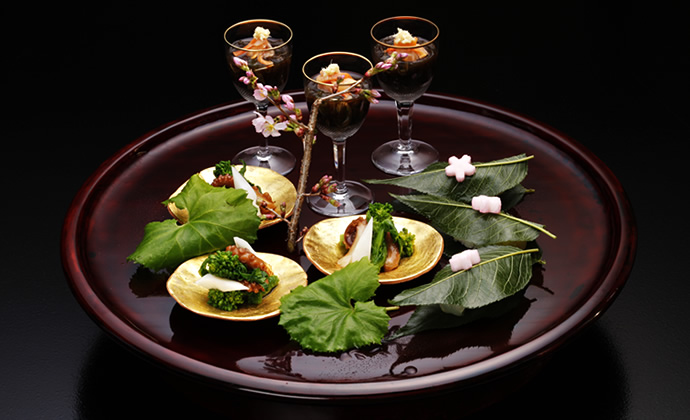 Since Japan is surrounded by ocean, seafood has always been a big part of Japanese cuisine, and rice. Originally, it was raw fish arinated in salt to keep it and eaten with seasoned rice. For sushi dishes do you use sushi rice, which is seasoned with a sweet vinegar mixture. Sushi has many kinds of fish but also without. Continue reading
Since Japan is surrounded by ocean, seafood has always been a big part of Japanese cuisine, and rice. Originally, it was raw fish arinated in salt to keep it and eaten with seasoned rice. For sushi dishes do you use sushi rice, which is seasoned with a sweet vinegar mixture. Sushi has many kinds of fish but also without. Continue reading
Happy New Year 2014
 Wagashi Gallery Continue reading
Wagashi Gallery Continue reading
Osechi-Ryori
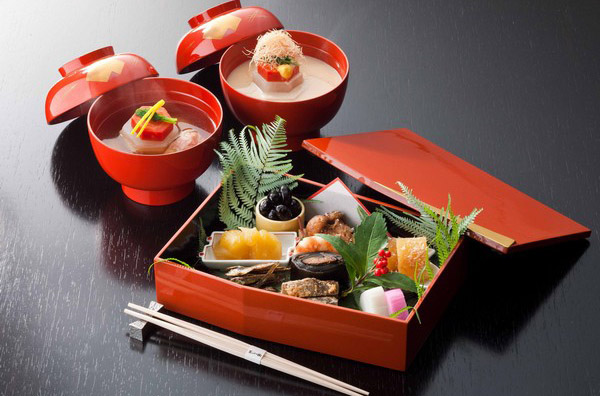 Japanese New Year’s food is called osechi-ryori, and colorful dishes are packed in layers of lacquer boxes, called jubako. The kinds of osechi dishes prepared at Japanese homes vary from region to region. Common dishes are kobumaki simmered kombu rolls, kuromame simmered black soy beans, kurikinton mashed sweet potato with sweet chestnuts, tazukuri candied dried sardines, and so on. Gobo burdock, renkon lotus roots, shrimps are often used ingredients. Also, various zoni mochi rice cake soup are commonly eaten during the holiday. Continue reading
Japanese New Year’s food is called osechi-ryori, and colorful dishes are packed in layers of lacquer boxes, called jubako. The kinds of osechi dishes prepared at Japanese homes vary from region to region. Common dishes are kobumaki simmered kombu rolls, kuromame simmered black soy beans, kurikinton mashed sweet potato with sweet chestnuts, tazukuri candied dried sardines, and so on. Gobo burdock, renkon lotus roots, shrimps are often used ingredients. Also, various zoni mochi rice cake soup are commonly eaten during the holiday. Continue reading
Kakigori
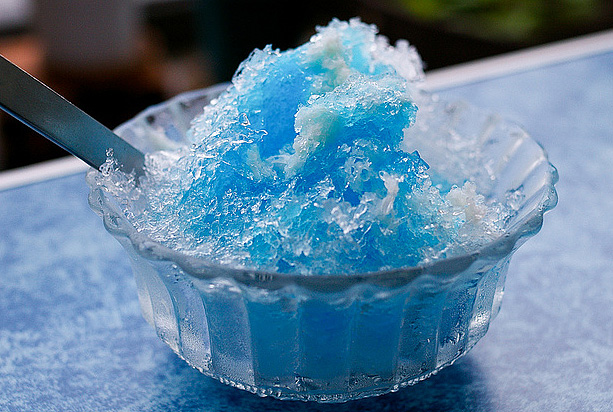 Kakigori is a Japanese shaved ice dessert flavored with syrup and condensed milk.
Kakigori is a Japanese shaved ice dessert flavored with syrup and condensed milk.
Popular flavors include strawberry, cherry, lemon, green tea, grape, melon, “Blue Hawaii,” sweet plum, and colorless syrup. Some shops provide colorful varieties by using two or more different syrups. To sweeten kakigori, condensed milk is often poured on top of it. It is not like a snow cone: It has a much smoother fluffier ice consistency, much like fresh fallen snow, and a spoon is almost always used to eat it. The traditional way of making kakigori uses a hand cranked machine to spin a block of ice over an ice shaving blade. Even though electric ice shavers are most often used, street vendors can still be seen hand-shaving ice blocks in the summer. Continue reading
Food Art
From Ukai Japan
Continue reading
Lotus Root
This well-known, permanent water plant with its beautiful white and pink lily flowers, coming from Asia. Not all water-lily is the only edible root and stem. It has a crispy fibrous structure with a mild, distinctive taste, some say that it looks like artichoke.
They can be cooked in many ways: fried/roast mixed with other vegetables, which are used in vegetarian dishes, dried, boiled in soup, or candied. It is also used raw insalads, cut into slices at a very attractive appearance. In addition, they also have a special starch that is very useful.
Narazuke
Narazuke are deep brown pickles native to the Nara Region of Japan, from which they get their name. Vegetables, typically daikon, uri or cucumber, are soaked in sake lees kasuzuke in a process where they may cure for several years. As a result the pickles have a strong, pungent flavor which is often punctuated with an overtly alcoholic bite.

Sake
Myths about Sake
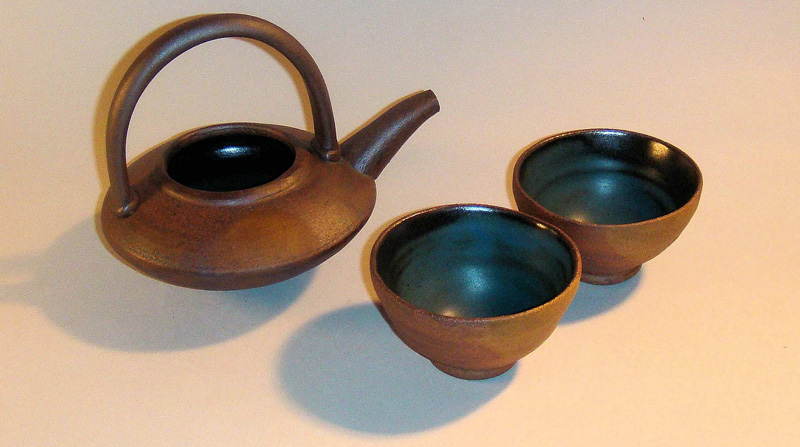 If you perchance to Japanese sake, you know that means “alcoholic beverage” plain and simple. Rice Wine’s real name is Nihonshu, but it was considered too difficult for Western countries when exports once came up. The short and pithy sake was much easier to absorb. The reason for that sake more often than not have an accent over the last letter is that the English would not pronounce it wrong. It had become sejk, as in “heaven’s sake” … Continue reading
If you perchance to Japanese sake, you know that means “alcoholic beverage” plain and simple. Rice Wine’s real name is Nihonshu, but it was considered too difficult for Western countries when exports once came up. The short and pithy sake was much easier to absorb. The reason for that sake more often than not have an accent over the last letter is that the English would not pronounce it wrong. It had become sejk, as in “heaven’s sake” … Continue reading
Umeshu
 Umeshu from steeping ume fruits while still unripe and green.
Umeshu from steeping ume fruits while still unripe and green.
Umeshu is a Japanese liqueur with more than 1,000 years of history. It is made of Ume apricot, alcohol and sugar and very popular in Japan. There are more than 300 private Umeshu labels and many households also make their own liqueur. The purpose of this lens is to share knowledge about Umeshu in generals, Umeshu labels, their producers and to show how its production works. Continue reading
Senmaizuke
Rakkyo
Takuan
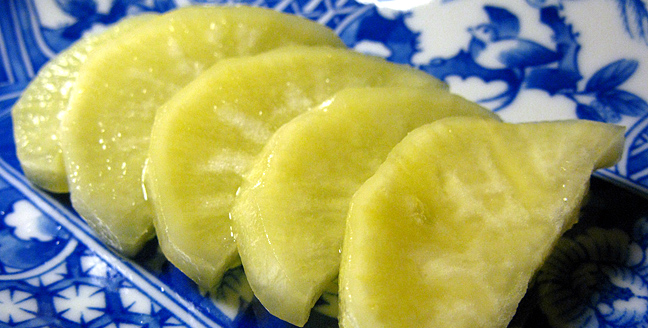 Takuan is made of Japanese radishes daikon, which have been sun dried and pickled in a mixture of salt, rice bran and sugar. The finished product is a sweet, crunchy pickle that is sliced and served alongside rice or other dishes. Takuan ranges from brownish white to fluorescent yellow in color. In Akita Prefecture they are additionally smoked and enjoyed as iburigakko.
Takuan is made of Japanese radishes daikon, which have been sun dried and pickled in a mixture of salt, rice bran and sugar. The finished product is a sweet, crunchy pickle that is sliced and served alongside rice or other dishes. Takuan ranges from brownish white to fluorescent yellow in color. In Akita Prefecture they are additionally smoked and enjoyed as iburigakko.
Gari
 Most tourists are probably already familiar with gari, the thin slices of sweet pickled ginger that is served alongside sushi. Gari has a sweet and sour flavor with a slightly spicy bite. It is meant to be eaten between sushi pieces as a palate cleanser, so that the unique flavor of each piece can be fully appreciated. Gari is naturally light yellow, but may also be dyed pink.
Most tourists are probably already familiar with gari, the thin slices of sweet pickled ginger that is served alongside sushi. Gari has a sweet and sour flavor with a slightly spicy bite. It is meant to be eaten between sushi pieces as a palate cleanser, so that the unique flavor of each piece can be fully appreciated. Gari is naturally light yellow, but may also be dyed pink.
Shibazuke
Umeboshi
 Umeboshi are Japanese plums, related to apricots, which have been salted and dried. The wrinkly red pickles are extremely salty and sour, although sweeter versions exist. Umeboshi serve as a preservative and digestive. They are eaten with all types of traditional meals, and often accompany the rice in boxed lunches (bento). Umeboshi are also one of the most popular fillings for rice balls onigiri.
Umeboshi are Japanese plums, related to apricots, which have been salted and dried. The wrinkly red pickles are extremely salty and sour, although sweeter versions exist. Umeboshi serve as a preservative and digestive. They are eaten with all types of traditional meals, and often accompany the rice in boxed lunches (bento). Umeboshi are also one of the most popular fillings for rice balls onigiri.
Tsukemono
Japanese pickles, Tsukemono are an important part of the Japanese diet. They are served with practically every traditional meal alongside rice and miso soup. They are valued for their unique flavors and commonly used as a garnish, relish, condiment, palate cleanser or digestive.
Tsukemono first appeared way back in Japanese history in the days before refrigeration when pickling was used to preserve food. As a result, some traditionally prepared types of pickles can be kept practically indefinitely. The different methods used to make tsukemono vary from a simple salting or vinegar brining, to more complicated processes involving cultured molds and fermentation. Continue reading
Chawan
Chawan or tea bowl is a bowl used for preparing and drinking matcha in the Japanese tea ceremony. There are many types of chawan used in tea ceremony, and the choice of their use depends upon many considerations. In Japan, “chawan” also is the standard term for bowls for rice. If it is necessary to distinguish between them, bowls for rice are called gohan jawan, while the those for use in tea ceremony are called matcha-wan.
Tofu
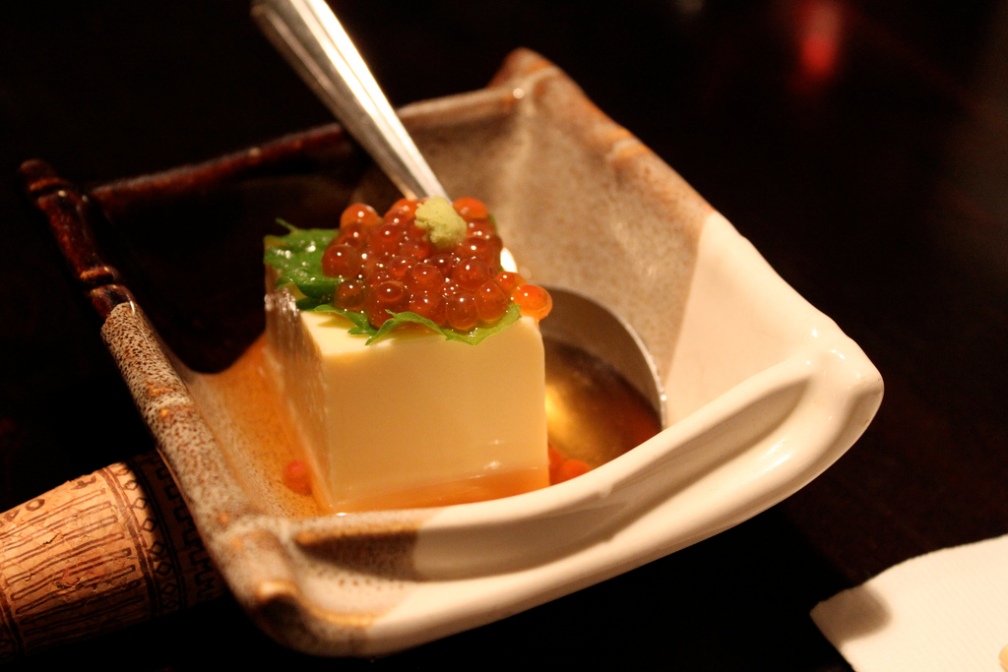 A staple in Asia for 2,000 years, tofu is known for its extraordinary nutritional benefits, as well as its versatility. Tofu, also known as soya curd, is a soft cheese-like food made by curdling soya milk with a coagulant. Tofu is a rather bland tasting product that easily absorbs the flavours of the other ingredients. Tofu is sold in water-filled packs or in aseptic cartons. Fresh tofu is usually packaged in water and should be refrigerated and kept in water until used. If the water is drained and changed daily, the tofu should last for one week. Tofu can be frozen for up to three months. Freezing will change its texture however, it will make the tofu slightly chewier.
A staple in Asia for 2,000 years, tofu is known for its extraordinary nutritional benefits, as well as its versatility. Tofu, also known as soya curd, is a soft cheese-like food made by curdling soya milk with a coagulant. Tofu is a rather bland tasting product that easily absorbs the flavours of the other ingredients. Tofu is sold in water-filled packs or in aseptic cartons. Fresh tofu is usually packaged in water and should be refrigerated and kept in water until used. If the water is drained and changed daily, the tofu should last for one week. Tofu can be frozen for up to three months. Freezing will change its texture however, it will make the tofu slightly chewier.
Otsukuri
Daifuku
 Daifukumochi, or Daifuku means great luck, is a Japanese confection consisting of a small round mochi stuffed with sweet filling, most commonly anko, sweetened red bean paste made from azuki beans. Daifuku comes in many varieties. The most common is white-, pale green-, or pale pink-colored mochi filled with anko. These come in two sizes, one approximately the diameter of a half-dollar coin, the other palm-sized. Some versions contain whole pieces of fruit, mixtures of fruit and anko, or crushed melon paste. Nearly all daifuku are covered in a fine layer of corn or potato starch to keep them from sticking to each other, or to the fingers. Some are covered with confectioner’s sugar or cocoa powder.Though mochitsuki is the traditional method of making mochi and daifuku, they can also be cooked in the microwave.
Daifukumochi, or Daifuku means great luck, is a Japanese confection consisting of a small round mochi stuffed with sweet filling, most commonly anko, sweetened red bean paste made from azuki beans. Daifuku comes in many varieties. The most common is white-, pale green-, or pale pink-colored mochi filled with anko. These come in two sizes, one approximately the diameter of a half-dollar coin, the other palm-sized. Some versions contain whole pieces of fruit, mixtures of fruit and anko, or crushed melon paste. Nearly all daifuku are covered in a fine layer of corn or potato starch to keep them from sticking to each other, or to the fingers. Some are covered with confectioner’s sugar or cocoa powder.Though mochitsuki is the traditional method of making mochi and daifuku, they can also be cooked in the microwave.
Chopsticks
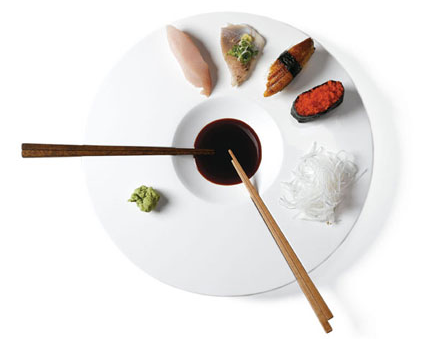 In much of Asia, especially the so-called “rice bowl” cultures of China, Japan, Korea, and Vietnam, food is usually eaten with chopsticks.
In much of Asia, especially the so-called “rice bowl” cultures of China, Japan, Korea, and Vietnam, food is usually eaten with chopsticks.
Chopsticks are two long, thin, usually tapered, pieces of wood. Bamboo is the most common material, but they are also be made of various types of wood, as well as plastic, porcelain, animal bone, ivory, metal, coral, agate, and jade. Continue reading



